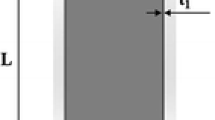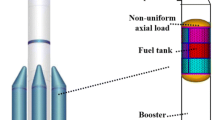Abstract
The hydrodynamic shape of the heaving buoy is an important factor of the motion response in waves and thus concerns the energy conversion efficiency for the point absorbers (PAs). The current experience-based designs are time consuming and not very efficient, hence, faster and smarter methods are desirable. An automated optimization method based on a fully parametric modeling method and computational fluid dynamics (CFD), is proposed in this paper. Using this method, a benchmark buoy is screen designed and then optimized by maximizing the heave motion response. The geometry is described parametrically and deformed by means of the free-form deformation (FFD) method. During the optimization process, the expansion factor of control points is the basis for the variations. A combination of the Sobol and the non-dominated sorting genetic algorithm II (NSGA-II) is used to search for the solutions. After several iterations, the heaving buoy shape with optimal heave motion response is obtained. The analyses show that the heave motion response has increased 55.3% after optimization. The developed methodology is valid and seems to be a promising way to design a novel buoy that can significantly improve the wave energy conversion efficiency of the PAs in future.
Similar content being viewed by others
References
Energy in China’s New Era [R], The State Council Information Office of the People’s Republic of China, 2020(in Chinese).
Fostering a blue economy: Offshore renewable energy [R]. IRENA, 2020.
Annual Report: An Overview of Ocean Energy Activities in 2021 [R]. IEA-OES, 2022.
Ahamed R., McKee K., Howard I. Advancements of wave energy converters based on power take off (PTO) systems: A review [R]. Ocean Engineering, 2020, 204: 107248.
Magagna D., Monfardini R., Uihlein A. JRC Ocean Energy Status Report: 2016 Edition, EUR 28407 EN (JRC104799) [R]. Luxembourg, Luxembourg: Publications Office of the European Union, 2016, 10–13.
Garcia-Teruel A., Forehand D. I. M. A review of geometry optimisation of wave energy converters [J]. Renewable and Sustainable Energy Reviews, 2021, 139: 110593.
Birk L. Application of constrained multi-objective optimization to the design of offshore structure hulls [J]. Journal of Offshore Mechanics and Arctic Engineering, 2008, 131(1): 011301.
Pastor J., Liu Y. Frequency and time domain modeling and power output for a heaving point absorber wave energy converter [J]. International Journal of Energy and Environmental Engineering. 2014, 5(2): 101.
Berenjkoob M. N., Ghiasi M., Soares C. G. Influence of the shape of a buoy on the efficiency of its dual-motion wave energy conversion [J]. Energy, 2021, 214: 118998.
Ansarifard N., Kianejad S. S., Fleming A. et al. Design optimization of a purely radial turbine for operation in the inhalation mode of an oscillating water column [J]. Renewable Energy, 2020, 152: 540–556.
Priftis A., Boulougouris E., Turan O. et al. Parametric design and multi-objective optimisation of containerships [J]. Ocean Engineering, 2018, 156: 347–357.
Amiri A., Panahi R., Radfar S. Parametric study of two-body floating-point wave absorber [J]. Journal of Marine Science and Application, 2016, 15(1): 41–49.
Gao H., Wang Z. Hydrodynamic response analysis and wave energy absorption of wave energy converters in regular waves [J]. Marine Technology Society Journal, 2017, 51(1): 64–74.
Shi H., Huang S., Cao F. Hydrodynamic performance and power absorption of a multi-freedom buoy wave energy device [J]. Ocean Engineering, 2019, 172: 541–549.
Shi H., Han Z., Zhao C. Numerical study on the optimization design of the conical bottom heaving buoy convertor [J]. Ocean Engineering, 2019, 173: 235–243.
Baghdadi M., Elkoush S., Akle B. et al. Dynamic shape optimization of a vertical-axis wind turbine via blade morphing technique [J]. Renewable Energy. 2020, 154: 239–251.
Zong Z., Hong Z., Wang Y. et al. Hull form optimization of trimaran using self-blending method [J]. Applied Ocean Research, 2018, 80: 240–247.
McCabe A. P. Constrained optimization of the shape of a wave energy collector by genetic algorithm [J]. Renewable Energy, 2013, 51: 274–284.
Edwards E. C., Yue D. K. P. Optimisation of the geometry of axisymmetric point-absorber wave energy converters [J]. Journal of Fluid Mechanics, 2022, 933: A1.
Garcia-Teruel A., DuPont B., Forehand D. I. M. Hull geometry optimisation of wave energy converters: On the choice of the objective functions and the optimisation formulation [J]. Applied Energy, 2021, 298: 115952.
Guo B., Ringwood J. V. Geometric optimisation of wave energy conversion devices: A survey [J]. Applied Energy, 2021, 297: 117100.
Saltelli A., Annoni P., Azzini I. et al. Variance based sensitivity analysis of model output. Design and estimator for the total sensitivity index [J]. Computer Physics Communications, 2010, 181(2): 259–270.
Zhang Z., Liao C., Chai H. et al. Multi-objective optimization of controllable configurations for bistable laminates using NSGA-II [J]. Composite Structures, 2021, 266: 113764.
Jiao J., Huang S., Guedes Soares C. Numerical investigation of ship motions in cross waves using CFD [J]. Ocean Engineering, 2021, 223: 108711.
Cheng Y., Lien F. S., Yee E. et al. A comparison of large eddy simulations with a standard k-ε Reynolds-averaged Navier-Stokes model for the prediction of a fully developed turbulent flow over a matrix of cubes [J]. Journal of Wind Engineering and Industrial Aerodynamics, 2003, 91(11): 1301–1328.
Zhang H., Zhou B., Vogel C. et al. Hydrodynamic performance of a floating breakwater as an oscillatingbuoy type wave energy converter [J]. Applied Energy, 2020, 257: 113996.
Quérard A., Temarel P., Turnock S. R. Influence of viscous effects on the hydrodynamics of ship-like sections undergoing symmetric and anti-symmetricmo- tions, using RANS [C]. ASME International Conference on Offshore Mechanics and Arctic Engineering, Estoril, Portugal, 2008.
Chen W., Liu J., Li J. et al. Wave energy assessment for the nearshore region of the northern South China Sea based on in situ observations [J]. Energy Reports, 2022, 8: 149–158.
Sederberg T. W., Parry S. R. Free-form deformation of solid geometric models [J]. ACM SIGGRAPH Computer Graphics, 1986, 20(4): 151–160.
Rababah A., Al-Shbool A. The transformation matrix of Chebyshev III-Bernstein polynomial basis [J]. AIP Conference Proceedings, 2016, 1738(1): 050007.
Tao J., Sun G., Si J. et al. A robust design for a winglet based on NURBS-FFD method and PSO algorithm [J]. Aerospace Science and Technology, 2017, 70: 568–577.
Priftis A., Boulougouris E., Turan O. Parametric design and holistic optimisation of post-panamax containerships [C]. 13th International Marine Design Conference (IMDC 2018), Helsinki, Finland, 2018.
Soultanias I. Parametric ship design and holistic design optimisation of a 9K TEU container carrier [D]. Diploma, Athens, Greece: National Technical University of Athens, 2014.
Koutroukis G., Papanikolaou A., Nikolopoulos L. et al. Multi-objective optimization of container ship design [J]. Mediterranean Marine Science, 2013, 477.
Papanikolaou A. A holistic approach to ship design [M]. Berlin, Germany: Springer, 2021.
Friendship Systems, 2017 Friendship Systems CAESES 4.2.1 Edition [R]. 2017.
Shi H., Huang S., Cao F. Hydrodynamic performance and power absorption of a multi-freedom buoy wave energy device [J]. Ocean Engineering, 2019, 172: 541–549.
Acknowledgements
This work was supported by the Key Area Research and Development Program of Guangdong Province (Grant Nos. 2021B0101200002, 2021B0202070002), the Natural Science Foundation of Guangdong Province (Grant Nos. 2022A1515011285, 2021A1515011771) and Innovation Group Project of Southern Marine Science and Engineering Guangdong Laboratory (Zhuhai) (Grant No. SML2022008).
Author information
Authors and Affiliations
Corresponding author
Ethics declarations
Ethical approval: This article does not contain any studies with human participants or animals performed by any of the authors.
Additional information
Compliance with Ethical Standards
Conflict of Interest: The authors declare that they have no conflict of interest.
Informed consent: Informed consent was obtained from all individual participants included in the study.
Project supported by the National Natural Science Foundation of China (Grant No. 52271301).
Biography: Shuo Huang (1984-), Female, Ph. D., Associate Professor
Rights and permissions
About this article
Cite this article
Huang, S., Liu, Wq., Wang, K. et al. Shape optimization design of a heaving buoy of wave energy converter based on fully parametric modeling and CFD method. J Hydrodyn 34, 1081–1094 (2022). https://doi.org/10.1007/s42241-022-0080-x
Received:
Revised:
Accepted:
Published:
Issue Date:
DOI: https://doi.org/10.1007/s42241-022-0080-x




